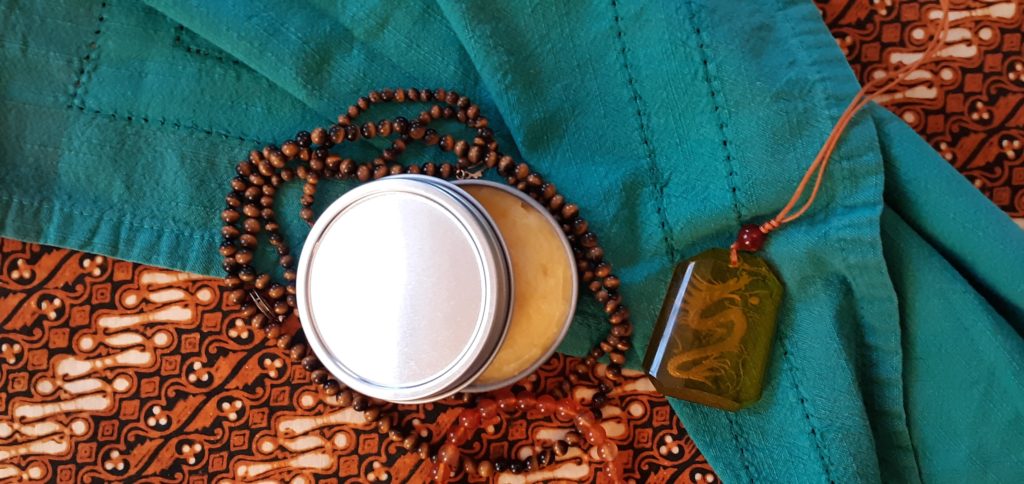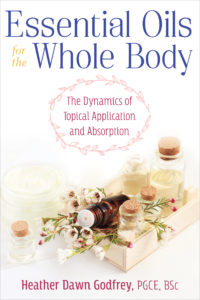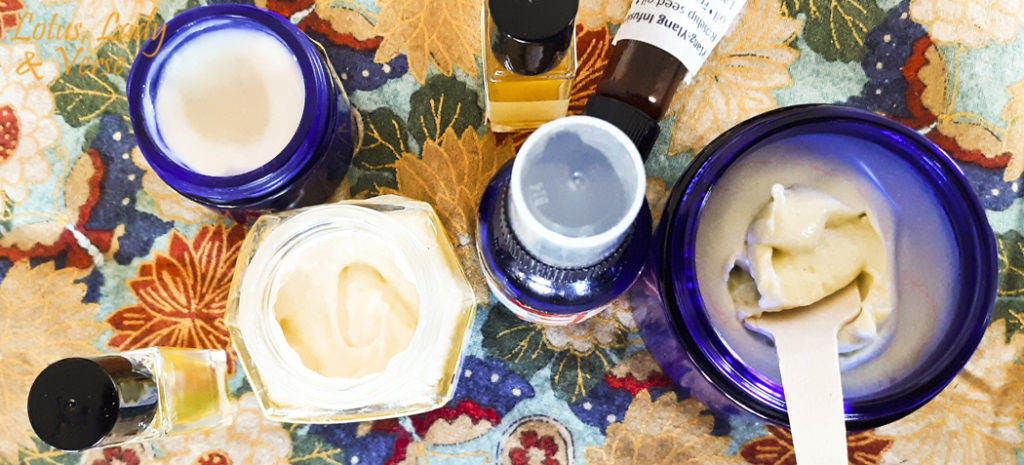Did you know that energy in human beings resonates with colored light?
Light allows us to actually see colors. Because light itself is effusive, we can’t catch and hold it. But there’s also a denser, physical kind of colored light. Colored pigments are understood as things. They’re part of objects that we can grasp and use.
Recognizable objects such as gemstones are colored by pigment. Colored pigments are also visible to a lesser extent in essences. An essence such as the product of plant distillation is known as an essential oil.

Do essential oils have energy?
If so, what’s the value of adding color energy to already energetic essential oils? Well, it turns out that color actually impacts the properties of an oil, increasing or decreasing energy where healing is needed.
So says Heather Dawn Godfrey in her new book, Essential Oils for the Whole Body, published by Healing Arts Press in November, 2019.
 Godfrey, an aromatherapist, selected 15 essential oils to address psychological imbalance and common physical diseases. As a group they are called the Serenity Oils. She describes how Serenity aromas and their connections to colors can regulate the distribution of energy in the body.
Godfrey, an aromatherapist, selected 15 essential oils to address psychological imbalance and common physical diseases. As a group they are called the Serenity Oils. She describes how Serenity aromas and their connections to colors can regulate the distribution of energy in the body.
While the book appears to be a self-help guide on the safe use of essential oils, there are many points of interest for a practicing aromatherapist. I was attracted to the ideas of using light, energy centers, and subtle connections that Godfrey incorporates throughout her discussion of using essential oils for wellbeing.
Charts Show How to Balance Energy
Graphical charts are seen throughout Essential Oils for the Whole Body. Some charts offer basic information on essential oils, while others associate Serenity oils with gemstones, plus other subtle energies such as Yin and Yang for example.
One chart shows a selection of oils for 24 different emotional conditions.
I noticed that 10 essential oils can relieve anxiety, depression, insomnia, and nervous tension. As well, I see there’s a really broad spectrum of healing oils for emotional conditions. The possibility of transforming imbalance, then, looks like it’s within reach.
Godfrey explains that the pairing of essential oils and gemstones is a method of healing. With this technique, subtle energies combine with essential oils to relieve an imbalance in energy. Then essential oils with their corresponding gemstones and colors can address discomfort and pain.
From an aromatherapist’s point of view, knowledge of human anatomy is vital to any practice. The endocrine, respiratory, and integumentary systems in particular, serve to inform the use essential oils for healing. Properties of the oils are found throughout Essential Oils for the Whole Body and in Profiles, a section which portrays the characteristics of each Serenity Oil.
A state of balance can be achieved by potent aromatic and medicinal oils. Because gemstones reinforce aromas and properties, they can assist in balancing energy, according to Godfrey. In the end, a smaller amount of essential oil is necessary to achieve expected results.
Charts Reveal Characteristics of Chakras
Features of each energy node are compiled in the chart, “The Chakras: Connections and Associations”.
In a review of chakras, or energy nodes, Godfrey describes these points of energy as a part of the body and organs involved, but also the emotional aspect, which that body part expresses.
Godfrey’s “connections and associations” chart for the chakras has assigned the following features for the heart chakra:
compassion, emotion, patience, self-determination, self-love, tolerance and acceptance… etc.
The combined energy of a chakra with the person’s emotional response makes that chakra either strong or weak. When all chakras are balanced, a state of wellbeing is achieved. Thus, when a particular body part is in pain, the energy imbalance in the energy center might uncover the reason for distress.
What fascinates me is that you need two colors, rather than one, in order to balance an energy. How this works, says Godfrey, is that the two colors must be complementary, meaning opposite colors. Yellow is opposite of violet. As a pair, they create a kind of friction or movement. Then the combined energy of the two colors can “resonate with” a chakra.
Choosing Gemstones for Color Energy
Color energy from two gemstones can affect healing. Godfrey’s specific data helps to choose the appropriate color energy or gemstone to go with a Serenity oil or blend.
To alleviate sleep issues, you could choose from one of Godfrey’s essential oils. Geranium (Pelargonium graveolens) essential oil helps balance your emotions. It also regulates the activities of your solar plexus, a very important chakra or energy center, just below your sternum and rib cage.
If you decide on Geranium to support the solar plexus, you’ll also note that Geranium is symbolized by the color yellow. And consequently, the yellow-golden gemstones such as Citrine or Amber or Tiger’s Eye are associated with Geranium essential oil.
Associated with gold-hued colors and gemstones, Geranium positively affects mood, nervous tension, and mood swings (and a number of other conditions, p. 209) because it stabilizes your solar plexus. It sorts through all your influencers and stressors in a physical way.
So, knowing that the chakra or bodily energy node called solar plexus corresponds to golden-colored gemstones, we also find information on opposing energies. The opposite of yellow is violet, hence the gemstone to balance citrine, etc. is amethyst, a violet colored gem.
3 Elements of Application
Three elements of application are key to effective essential oil use. They are absorption, blending, and safety issues.

Absorption is possible through breathing, skin contact, and ingestion. To wit, I think the title phrase, “The Dynamics of Topical Application and Absorption” speaks to the very question of how oils can increase wellness. You might say that absorption is at the heart of the matter.
But although absorption is critical, combining oils is the 2nd element to consider. Blending creates different effects, aesthetic and/or therapeutic. Godfrey’s method of blending combines the art of selection and perfumer’s sense of odor characteristics.
The third element of application is safety. For issues of safety, I don’t think her point of view is unique, as most aromatherapists are attuned to safe delivery of the oils, no matter the pathway. However, her indications for safety include data on essential oil contraindication in pregnancy and use with children. Specific oils are mentioned in charts, which is very helpful for quick reference. Godfrey also advises that for most applications to the skin, you should dilute essential oils to between 1% and 5% concentration in a carrier medium.
Find Your Oil and Make a Potion
Two more topics in Essential Oils for the Whole Body provide practical advice. Each of the 15 essential oils is described from native plant environment to oil in the bottle. Godfrey then gives instructions on how to create products for topical application.
Profiles is a mini reference manual on each of the 15 Serenity Oils. This section is typical of materia medica, but in Essential Oils for the Whole Body there are also colors, gemstones, chakras, energies, and elements relevant to each oil. As well, and given in even more detail, are odor descriptions, safety data, and chemical constituents. These expose a vaster playing field than I might have guessed.
Provided in Applications are Godfrey’s recipes for 15 different types of application — ointments, lotions, creams, face masks, compresses, resin burners, diffusors — ways to use the potential of essential oils to affect healing and grace. One shown at top has Rosehip Seed Oil, Sunflower Oil, Beeswax, and a blend of essential oils for relief of painful skin splits around nails.
My Conclusions
At first, I thought that the many details of human anatomy, which can be found elsewhere, takes away from the impact of Godfrey’s message on the essential oils themselves.
But not quite. After considering her description of subtle connections, I had an ah-ha moment. It seemed to me that if essential oils combine with subtle energies in a healing technique, a bridge would be provided in the text between the Eastern and Western ideas.
And so a bridge, or crosswalk does exist with essential oils. For example, I’ve selected an essential oil to help with personal power, self-confidence and self-expression. And because the bodily function of digestion is also related to these emotions, then the digestion of experiences will also be positively affected. Taken together, the significance of two systems seems obvious, yet Godfrey’s manner of expressing these details offers the reader several options.
Indeed, Godfrey describes Western and Eastern concepts with equal sensitivity. She’s chosen to highlight non-Western perspectives. Portraying energy as a collaboration between the mind and the body, Godfrey discusses the 7 Chakras and the Chinese way of Yin and Yang.
Godfrey’s considerable knowledge combined with her ability as teacher is also mindful of connections and correspondences. This passion for the energy of light and color with essential oils brings forth the possibility that transformation is at hand!
Read more about Heather Dawn Godfrey at Inner Traditions website here.
Read my review of her first book, Essential Oils for Mindfulness and Meditation, here.
Follow


